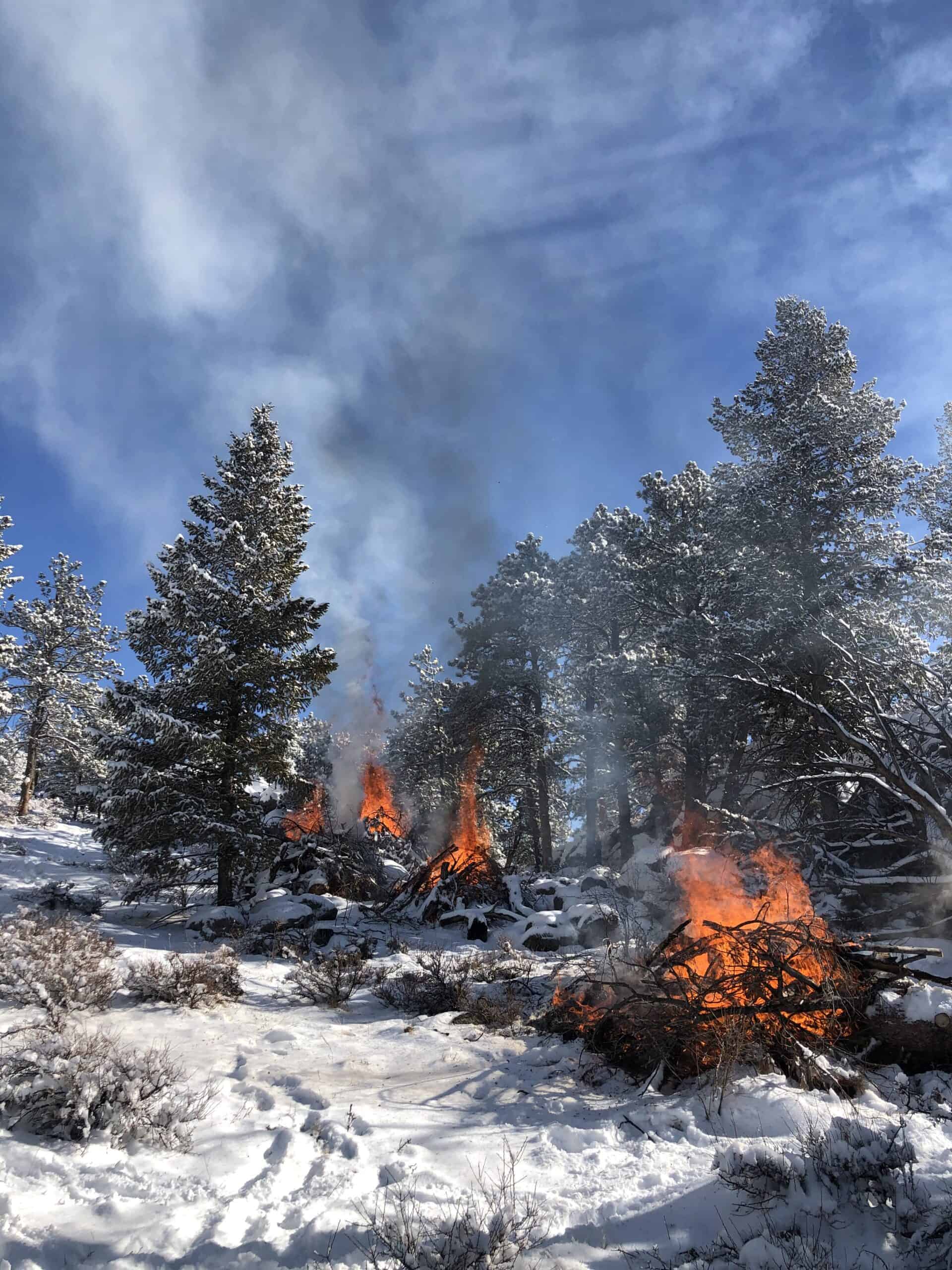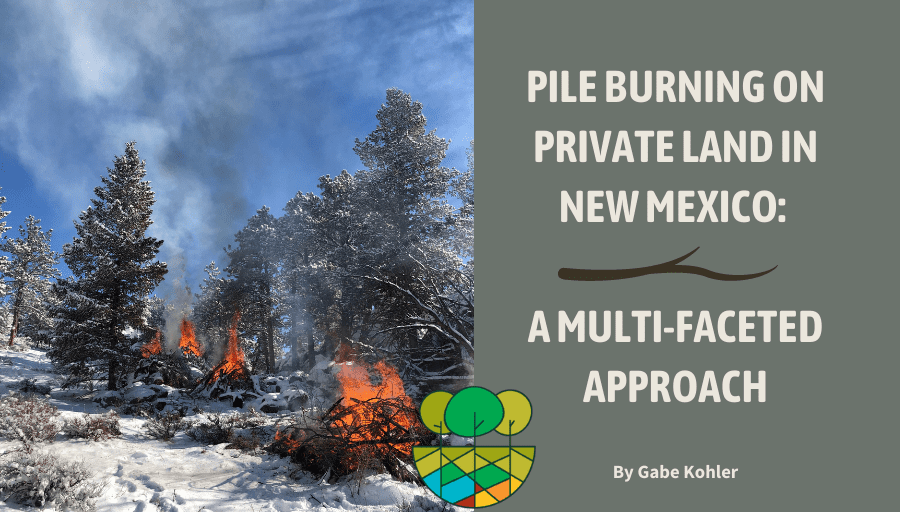Editors’ Note: Gabe Kohler is a Program Manager with the Forest Stewards Guild in New Mexico. In his work with the Guild, Gabe researches prescribed fire policy, implements pile burns as a red-carded Type II Firefighter, and coordinates education and outreach events through the Fire Adapted New Mexico learning network (FACNM). Here Gabe shares multiple, complimentary approaches to increasing the use of pile burning on private lands to support the ecologically appropriate reintroduction of fire at the landscape scale.
Across the West, increasing the use of prescribed fire on private land is necessary to reducing the risk of wildfire at the landscape scale. Pile burning is an essential tool for achieving wildfire risk reduction and forest health objectives on private land because these burns are typically less complex and often less risky because they can be completed in the winter when there is snow on the ground.
This blog focuses on three individual approaches that the Forest Stewards Guild is involved with related to pile burning on private lands in New Mexico, including advocacy for sensible prescribed fire policy, implementation of pile burns through our All Hands All Lands (AHAL) pile burning squad and education to residents about the benefits of using pile burning through the Fire Adapted New Mexico Learning Network (FACNM). These programs rely upon, and help to develop, a network of relationships and partnerships that help share information between these complementary approaches. Information about residents’ needs is captured and shared from the bottom-up and information about current and evolving policy is captured and shared from the top-down.
The New Mexico Prescribed Fire Act: A Policy Approach
 In 2017, with support from FAC Net, the Guild published a report titled, “Controlled Burning on Private Land” that was updated in 2019. Together, these reports identified some of the key organizational and legal issues that create barriers to controlled burning on private lands in New Mexico. These reports became part of a broader conversation that eventually led to the passage of House Memorial 42. Following the 2019 passage of House Memorial 42 by New Mexico Legislature, a Memorandum of Understanding was signed by the United States Department of the Interior Bureau of Land Management (BLM), New Mexico State Office and the New Mexico Association of Conservation Districts (NMACD) to encourage the use of prescribed burning on private land. Then, in 2019 New Mexico Legislature passed the Forest and Watershed Restoration Act, creating a potential funding source for projects that use prescribed fire to restore forests and mitigate fire risks. Finally, New Mexico’s Energy, Minerals, and Natural Resources Department (EMNRD) created a working group to develop and analyze the possibility of expanding the practice of prescribed fire in New Mexico.
In 2017, with support from FAC Net, the Guild published a report titled, “Controlled Burning on Private Land” that was updated in 2019. Together, these reports identified some of the key organizational and legal issues that create barriers to controlled burning on private lands in New Mexico. These reports became part of a broader conversation that eventually led to the passage of House Memorial 42. Following the 2019 passage of House Memorial 42 by New Mexico Legislature, a Memorandum of Understanding was signed by the United States Department of the Interior Bureau of Land Management (BLM), New Mexico State Office and the New Mexico Association of Conservation Districts (NMACD) to encourage the use of prescribed burning on private land. Then, in 2019 New Mexico Legislature passed the Forest and Watershed Restoration Act, creating a potential funding source for projects that use prescribed fire to restore forests and mitigate fire risks. Finally, New Mexico’s Energy, Minerals, and Natural Resources Department (EMNRD) created a working group to develop and analyze the possibility of expanding the practice of prescribed fire in New Mexico.
This working group was instrumental to the passage of the Prescribed Burning Act (HB57; NMSA 1978, Section 68-5-1 et seq.) in 2021. The New Mexico Prescribed Burning Act does the following:
- establishes a negligence standard for any prescribed burning on private lands**;
- creates a training program through New Mexico State University for landowners and contractors to build the skills to conduct prescribed burns safely;
- provides an incentive for landowners and contractors to get that training, so that they are only liable for actual damages instead of double damages. (Currently any landowner or their agent who conducts prescribed burning is liable for double damages; the Prescribed Burning Act reduces the damages to actual value for those who are trained and certified);
- creates a certification program through the Forestry Division; and
- creates a model prescribed burning permit for counties and municipalities to use if they choose to issue permits.
The work has not stopped there. Following the passage of the Prescribed Fire Act, the Guild continues to promote the use of prescribed fire by working between legislature and practitioners in the rule-making process for the 2021 Prescribed Fire Act. On the ground, the Guild continues to support the practice of prescribed fire on private land by providing call-when-needed firefighter capacity and burn bosses on non-federal land to assist with burn implementation (AHAL) and training opportunities across the state (FACNM).
The All Hands All Lands Pile Burning Squad: A Practical Approach
The All-Hands All-Lands Burn Team (AHAL) is a collaborative effort between The Nature Conservancy of New Mexico, the Rio Grande Water Fund, the Forest Stewards Guild, The Ember Alliance and many others to accelerate the return of fire to the frequent fire ecosystems in the Rio Grande Water Fund landscape. Not surprisingly, many of the partners involved in standing up the AHAL burn team have been central to the passage of the Prescribed Fire Act and continue to help with education and outreach events with residents through the Fire Adapted New Mexico Learning Network (FACNM).
The goal of the AHAL is to get ahead of prescribed fire backlogs on federal, state and tribal lands and support private landowner’s use of prescribed fire. To do this, we created the AHAL burn team to add capacity to existing efforts and to serve as a stand-alone organization that can complete burns with insured and qualified burn bosses. We also mobilize seasonal burn teams consisting of a mix of red-carded partners, contractors, staff and volunteers to amplify knowledge, skills and abilities. Lastly, we engage the public through stories, photos and opportunities for involvement, to raise awareness for forests and watersheds.

The All Hands All Lands crew at work. Photo by Gabe Kohler.
Historically, the AHAL burn team has engaged partners and call-when-needed firefighters, assembling diverse teams to support prescribed burns. As the fall of 2020 prescribed fire season approached, with COVID cases simultaneously spiking, it became necessary to shift to a nimble approach that avoided the risks of bringing together large groups. The result was the pile squad: a dedicated, four-person squad that was fully equipped and trained to implement pile burns on their own and could follow strict COVID policies.
As vaccines began to roll out and we were able to more safely bring people together to burn, we were able to contribute to 5,039 acres of fire in 2021. The 2020-2021 Pile Squad alone was able to accomplish over 75 acres burned in AHAL-led burns on private land.

All Hands All Lands burn piles. Photo by Gabe Kohler
The AHAL pile burning squad is set to implement more prescribed fire during the winter of 2022. To learn more about the AHAL pile squad, check out this story map.
Pile Burning Learning Exchange: An Education and Outreach Approach
In the Fall of 2021, the Guild coordinated a pile burning learning exchange through the Fire Adapted New Mexico learning network (FACNM). The goal of the event was to provide an opportunity for networking and peer learning around prescribed fire at the county scale. The event included classroom sessions in the morning and field-based demonstrations about pile construction, weather forecasting, PPE and more in the afternoon. The decision on whether or not to light a demonstration pile was dependent on a go-no-go checklist with the landowner on the day of the event.
With the 2021 rollout of the Prescribed Fire Act, the Guild and FACNM wanted to create a forum for discussion and open-up local conversations around the usage of pile burning to reduce wildfire risk. The event was planned in partnership with New Mexico State Forestry Division (NMSF), New Mexico State University Extension (NMSU), Mora County and local fire department chiefs. NMSF and NMSU were deeply involved in the passage of the Prescribed Fire act and helped to infuse the learning exchange with information about the recent legislation as well as best practices from their experience with pile burning on-the-ground.
The morning classroom sessions got off to a challenging start. Conversations about how the new simple negligence standard would be interpreted in court created a tone of uncertainty and fear that left many participants to express that they would not feel comfortable using fire. The potential legal implications of an escaped pile burn leading to a wildfire had some participants voicing frustration that the Prescribed Fire Act had landed on simple negligence standard as opposed to a more forgiving gross negligence standard**.

Pile Burning Learning Exchange in the classroom. Photo by Gabe Kohler.
In the afternoon, we pivoted to a field-based discussion with local firefighters that had experience with pile burning. The conversation shifted as firefighters and landowners shared their experiences using pile burning on their properties. Participants began to ask questions about burning in the winter, containment features and other ways that they could reduce the risk of pile burning to avoid the worst-case scenarios of ending up in court. Due to low relative humidity and wind speed, we did not end up meeting our target conditions for the burn and did not light our demonstration pile. We made sure to clearly describe how we came to this decision and the range of weather conditions that we had prescribed for live fire.
We had over 25 participants join us and received interest in future learning exchanges from counties across the state. Some participants of the exchange participated in a collaborative broadcast burn in the wildland urban interface (WUI) weeks later and were able to put some of what they learned into practice. This collaborative burn was implemented in partnership with The Ember Alliance and the State Land Office.

The Pile Burning Learning Exchange group gather in the field learning about the right conditions for pile burning. Photo by Gabe Kohler.
These three approaches the Guild has undertaken, from policy, to education, to on the ground action exhibit that a multifaceted approach is vital to achieving wildfire risk reduction and forest health objectives at the scale necessary. The widespread action and impact needed across our landscapes requires us to reach far and wide to engage an array of audiences, partners and community members. It is the only way to successfully return good fire to the landscape.
**For another perspective on the background to liability standards and on efforts in changing them in California checkout Lenya Quinn-Davidson’s blog.
* * * *


Are there any organizations like yours in Utah?